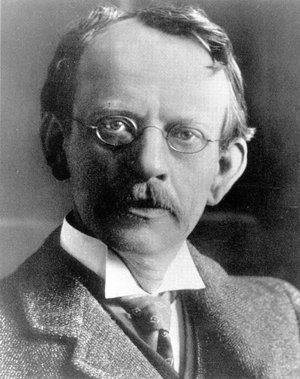Thomson’s Model: In the late 19th century, chemists and physicists were studying the relationship between electricity and matter. They were placing high voltage electric currents through glass tubes filled with low-pressure gas (mercury, neon, xenon) much like neon lights. Electric current was carried from one electrode (cathode) through the gas to the other electrode (anode) by a beam called cathode rays. In 1897, a British physicist, J. J. Thomson did a series of experiments with the following results:


He found that if the tube was placed within an electric or magnetic field, then the cathode rays could be deflected or moved.
By applying an electric field alone, a magnetic field alone, or both in combination, Thomson could measure the ratio of the electric charge to the mass of the cathode rays.
He found the same charge to mass ratio of cathode rays was seen regardless of what material was inside the tube or what the cathode was made of.
Thomson concluded the following:
Cathode rays were made of tiny, negatively charged particles, which he called electrons.
The electrons had to come from inside the atoms of the gas or metal electrode.
Because the charge to mass ratio was the same for any substance, the electrons were a basic part of all atoms.
Because the charge to mass ratio of the electron was very high, the electron must be very small.
Later, an American Physicist named Robert Milikan measured the electrical charge of an electron. With these two numbers (charge, charge to mass ratio), physicists calculated the mass of the electron as 9.10 x 10-28 grams. For comparison, a metal coin has a mass of 2.5 grams; so, 2.7 x 1027 or 2.7 billion billion billion electrons would weigh as much as a coin!
Two other conclusions came from the discovery of the electron:
Because the electron was negatively charged and atoms are electrically neutral, there must be a positive charge somewhere in the atom.
Because electrons are so much smaller than atoms, there must be other, more massive particles in the atom.
From these results, Thomson proposed a model of the atom that was like a watermelon. The red part was the positive charge and the seeds were the electrons.

Thomson’s Model:
Negatively charged electrons were located within a continuous distribution of positive charge. The positive charge was assumed to be spherical shape of radius 10-10m (This value can be obtained from the density of typical solid material, its atomic weight and Avogadro’s number).
– In the lowest energy state the electrons are fixed at their equilibrium positions.
– In excited atom at high temperature the electrons vibrate about their equilibrium position in simple harmonic motion.
Example:
Assume that there is one electron of charge -e inside spherical region of uniform positive charge density r (according to Thomson’s model). Show that the electron motion is in simple harmonic motion about the center of the sphere.

If the electron displaced by distance a (a<r), then the electric force acting on the electron is

The charge q can be found by the density of distribution r


![]()
Let
![]() F = – ka
F = – ka
This force will produce simple harmonic motion along the diameter of the sphere directed toward the center.
Example:
If the total positive charge in Thomson’s model are distributed uniformly over a sphere of radius 10-10m. Find the force constant k and the frequency of the motion.
Let the magnitude of the +ve charge = e and the radius of the +ve charge is r=10-10m
![]()

![]()
 this is the radiation emitted by the atom which have wavelength of
this is the radiation emitted by the atom which have wavelength of
![]()
This is the expected radiation from Thomson hydrogen atom.
Therefore Thomson hydrogen atom has only one frequency which contradict the real hydrogen spectra.



